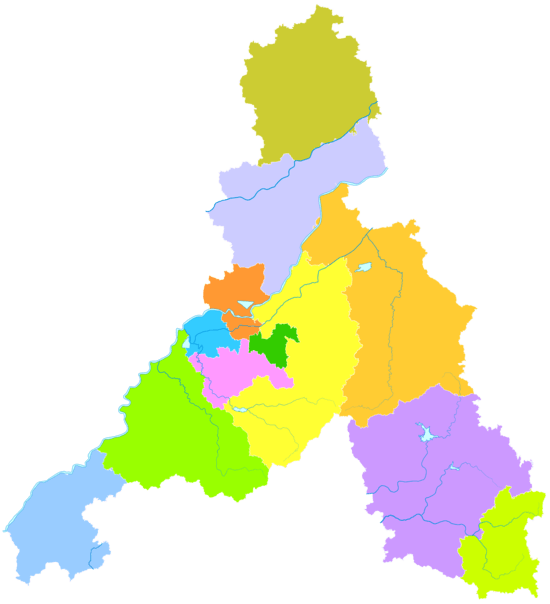Jinan
Jinan (Chinese: 济南; alternately romanized as Tsinan)[lower-alpha 1] is the capital of Shandong province in Eastern China.[3] With a population of was 6.8 million as of the 2010 census,[4] it is the second-largest city in Shandong after Qingdao. The area of present-day Jinan has played an important role in the history of the region from the earliest beginnings of civilization and has evolved into a major national administrative, economic, and transportation hub.[5] The city has held sub-provincial administrative status since 1994.[5][6] Jinan is often called the "Spring City" for its famous 72 artesian springs.[7]
Jinan 济南市 Tsinan, Chi-nan | |
|---|---|
Prefecture-level & Sub-provincial city | |
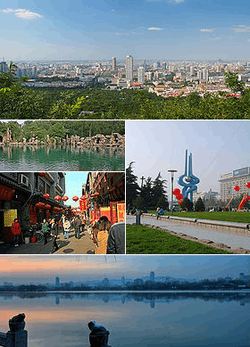 Clockwise from top: Jinan's Skyline, Quancheng Square, Daming Lake, Jinan Olympic Sports Center and Baotu Spring | |
| Nickname(s): City of Springs (泉城) | |
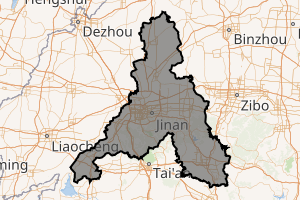
| |
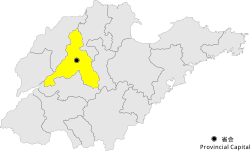 Location of Jinan City within Shandong | |
| Coordinates (Shandong People's Government): 36°40′13″N 117°01′15″E | |
| Country | People's Republic of China |
| Province | Shandong |
| County-level divisions | 12 |
| Township divisions | 166 |
| Municipal seat | Lixia District |
| Government | |
| • Party Secretary | Sun Licheng |
| • Mayor | Sun Shutao |
| Area | |
| • Prefecture-level & Sub-provincial city | 10,244 km2 (3,955 sq mi) |
| • Urban | 7,170.8 km2 (2,768.7 sq mi) |
| • Metro | 53,000 km2 (20,000 sq mi) |
| Elevation (Airport) | 23 m (75 ft) |
| Population (2018) | |
| • Prefecture-level & Sub-provincial city | 8,700,000 |
| • Density | 850/km2 (2,200/sq mi) |
| • Urban | 4,693,700 |
| • Urban density | 650/km2 (1,700/sq mi) |
| • Metro | 11,000,000 |
| • Metro density | 210/km2 (540/sq mi) |
| Time zone | UTC+8 (China Standard) |
| Postal code | 250000 |
| Area code(s) | 0531 |
| ISO 3166 code | CN-SD-01 |
| License plate prefixes | 鲁A, 鲁O, 鲁W, 鲁S |
| GDP (2018) | CNY 886.221 billion |
| - per capita | CNY 101,864.5 |
| Website | www.jinan.gov.cn (Chinese) |
| Jinan | |||||||||||||||||||||||||||||||||
|---|---|---|---|---|---|---|---|---|---|---|---|---|---|---|---|---|---|---|---|---|---|---|---|---|---|---|---|---|---|---|---|---|---|
.svg.png) "Jǐnán" in Simplified (top) and Traditional (bottom) Chinese characters | |||||||||||||||||||||||||||||||||
| Simplified Chinese | 济南 | ||||||||||||||||||||||||||||||||
| Traditional Chinese | 濟南 | ||||||||||||||||||||||||||||||||
| Literal meaning | "South of the Ji [River]" | ||||||||||||||||||||||||||||||||
| |||||||||||||||||||||||||||||||||
Names
As the letter N can be both syllable-final and syllable-initial in Mandarin Chinese, Hanyu Pinyin recommends that the city's name be spelled "Ji'nan" to avoid ambiguity with words pronounced "Jin'an" (e.g. 金安). This practice is however widely ignored.
The modern-day name Jinan literally means "south of the Ji" and refers to the old Ji River that had flowed to the north of the city until the middle of the 19th century. The Ji River disappeared in 1852[8] when the Yellow River changed its course northwards and took over its bed. The current pronunciation of the character "Ji" with the third tone ("jǐ") was established in the late 1970s. Prior to this, it was pronounced with the fourth tone ("jì"). Older texts spell the name as "Tsinan" (Wade-Giles romanization) or "Chi-nan".
During the times of the Zhou dynasty (1045 BC to 256 BC), the city of Lixia (simplified Chinese: 历下; traditional Chinese: 歷下; pinyin: Lìxià) was the major settlement in the area. The name "Lixia" refers to the location of Jinan at the foot of Mount Li, which lies to the south of the city). Today, Lixia is the name of one of the city's districts.
The Battle of An, which was fought in the area during the Spring and Autumn period (in 589 BCE) between the states of Qi and Jin, is named for the ancient city of Ān (Chinese: 鞍) which stood within the city limits of present-day Jinan. Marco Polo gives a brief description of Jinan under the name "Chingli"[9] or "Chinangli".[10] 19th and early 20th century texts frequently give the name of the city as "Tsinan Fu" where the additional "Fu" (Chinese: 府) comes from the dated Chinese term for a provincial capital (Chinese: 省府).
Jinan is also referred to by the nickname "City of Springs" (Chinese: 泉城), because of the many artesian springs in the urban city centre and its surroundings.
History
Early history
The area of present-day Jinan has been inhabited for more than 4000 years. The Neolithic Longshan culture was first discovered at Chengziya to the east of Jinan (Zhangqiu District) in 1928. One of the characteristic features of the Longshan culture are the intricate wheel-made pottery pieces it produced. Most renowned is the black "egg-shell pottery" with wall thicknesses that can go below 1 millimeter.[11]
During the Spring and Autumn period (722–481 BCE) and Warring States period (475–221 BCE), the area of Jinan was split between two states: the state of Lu in the west and the state of Qi in the east. In 685 BCE, the state of Qi started to build the Great Wall of Qi across Changqing county. Portions of the wall still remain today and are accessible as open air museums. Bian Que, according to the legend the earliest Chinese physician and active around 500 BCE, is said to have been a native of present-day Changqing County. Zou Yan (305–240 BCE), a native of Zhangqiu City, developed the concepts of Yin-Yang and the Five Elements. Joseph Needham, a British sinologist, describes Zou as "The real founder of all Chinese scientific thought."[12]
During the times of the Han dynasty (206 BCE – 220 CE), Jinan was the capital of the feudatory Kingdom of Jibei (simplified Chinese: 济北国; traditional Chinese: 濟北國; pinyin: Jǐbĕi Guó) and evolved into the cultural and economic hub of the region. The Han dynasty tomb where the last king of Jibei, Liu Kuan (刘宽; 劉寬; Liú Kuān), was buried at Shuangru Mountain was excavated by archaeologists from Shandong University in 1995 and 1996.[13] More than 2000 artifacts such as jade swords, jade masks, and jade pillows have been recovered within the 1,500 square meter excavation site, emphasizing the wealth of the city during the period.[14] Cao Cao (155 – 220 CE) was an official in Jinan before he became the de facto ruler of the Han dynasty.[15] His son, Cao Pi, overthrew the last emperor of the Han and founded the Wei Kingdom (220 – 265 CE) of the Three Kingdoms Period.
Beginning in the 5th century CE, Buddhism flourished in Jinan. The Langgong Temple (朗公寺; Lǎnggōng Sì, later renamed Shentong Temple, (神通寺; Shéntōng Sì, and now in ruins) in the southern county of Licheng was one of the most important temples in northern China at that time. The same period witnessed extensive construction of Buddhist sites in the southern counties of Licheng and Changqing such as the Lingyan Temple and the Thousand-Buddha Cliff. In particular, a large number of cave temples were established in the hills south of Jinan.[9]
Jinan remained the cultural center of the region during the Song dynasty (960 – 1279 CE). The Song rulers promoted Jinan to a superior prefecture in 1116 CE. Two of the most important poets of the Southern Song were both born in Jinan: Li Qingzhao (1084–1151 CE), the most renown female poet in Chinese history, and Xin Qiji (1140–1207 CE), who was also a military leader of the Southern Song dynasty. Both poets witnessed a series of crushing defeats of the Song dynasty at the hands of the Jurchens who gained control over almost half of the Song territories and established the Jin dynasty in northern China. After Jinan came under control of the Jin dynasty, both Li Qingzhao and Xin Qiji had to abandon their homes and reflected this experience in their works.
During the Civil War that followed the proclamation of Kublai Khan as Great Khan in 1260 CE, Jinan was at the center of a rebellion by Yizhou governor Li Tan against Mongol rule in 1262 CE. The rebellion was crushed in a decisive battle that was fought not far from Jinan in late March or early April 1262 CE. After losing 4000 of his troops in the battle, Li Tan retreated to Jinan to make his last stand. After defections of his defenders had made his position untenable, Li Tan tried to commit suicide by drowning himself in Daming Lake. However, he was rescued by the Mongols in order to execute him by trampling him to death with their horses.[16]
Despite such violent conflicts, culture in Jinan continued to thrive during the Jin (1115–1234) and Yuan (1271–1368) dynasties: One of the most renowned artists of the Yuan dynasty, Zhao Mengfu (1254–1322) was appointed to the post of governor of Jinan in 1293 and spent three years in the city. Among the extraordinary art works he completed during his stay in Jinan, the best known painting is "Autumn Colors on the Qiao and Hua Mountains" (《鹊华秋色》). Geographer Yu Qin (1284–1333) also served as an official in Jinan and authored his geography book Qi Cheng there.
When Shandong province was established under the Ming dynasty, Jinan became its capital.[9] Jinan was the site of a siege during the Jingnan Campaign where the city was defended by loyalists of the Jianwen Emperor led by Tie Xuan against the rebel Prince of Yan Zhu Di's army.
In 1852, the northward shift of the Yellow River into a new bed close to the city triggered the modern expansion of Jinan. The new course of the Yellow River connected the city to the Grand Canal and regional waterways in northern Shandong and southern Hebei.[9]
German influence in Jinan grew after the Qing dynasty ceded Qingdao to the German Empire in 1897. A German concession area was established to the west of the historical city center (in the vicinity of the Jinan Railway Station first established by the Germans). The Jiaoji (Qingdao–Jinan) railway was built by the Germans against local resistance.[17] Discontent over the construction of the railway was one of the sources fueling the Boxer Rebellion (1899–1901).[18] During the rebellion, foreign priests were evacuated from Jinan and Chinese Christians became a target of violence. The Jiaoji railway was completed in 1904, three years after the Boxer Rebellion had been put down, and opened the city to foreign trade.[9] The importance of Jinan as a transportation hub was cemented with the completion of the north–south Jinpu railway from Tianjin to Pukou in 1912.[9] Jinan became a major trading center for agricultural goods in northern China. Traded commodities included cotton, grain, peanuts, and tobacco.[9] Jinan also developed into a major industrial center, second in importance to Qingdao in the province.
Republican era
In 1919, after the First World War, the Japanese took over the German sphere of influence in Shandong, including control of the Jiaoji railway, and established a significant Japanese influence in Jinan.[9] According to estimates by a contemporary Japanese government official, about 2,000 Japanese were living in Jinan in 1931, about half of whom were involved in the opium trade for which the Japanese had a loosely controlled monopoly that was exploited with the participation of Chinese traders.[19]
During the Warlord era of the Republic of China, Zhang Zongchang, nicknamed the "Dogmeat General",[20] ruled Shandong from Jinan for a period that lasted from April 1925 until May 1928. Zhang was unpopular for his heavy-handed rule and in particular his heavy taxation.[21] Besides heavy taxes, he relied financially on opium to finance his periodic wars.[19] Zhang even planned to use some of the wealth extracted from these sources for building a living shrine and a large bronze statue for himself on the shore of Daming Lake, but these plans were not realized as his rule came to an end.
In the spring of 1928, the Kuomintang's Northern Expedition reached Jinan.[22] On May 3, 1928, clashes developed between Japanese troops stationed in Jinan and the Kuomintang troops moving into the city (Jinan Incident).[23] Cai Gongshi, a Kuomintang emissary sent to negotiate and 16 members of his entourage were cruelly executed by the Japanese. Japanese officers placed an order to slice off his nose and ears, and to gouge out his eyes and tongue. Sixteen other members of his negotiation team were also striped naked, recklessly whipped, dragged to the back-lawn, and slaughtered by machine guns on the same day.[24] After the incident, Japanese reinforcements were sent to Shandong and by 11 May, Japanese troops pushed the Chinese troops from the area, inflicted thousands of casualties[25] and killed over 2000 Chinese civilians.[26] The Japanese occupied Jinan for more than six months until they withdrew to their garrison in Tsingtao on the 28th of March 1929. When Chiang lectured a group of Chinese army cadets, he urged them to turn their energies to washing away the shame of Jinan, but to conceal their hatred until the last moment.[27] The Kuomintang government later decreed that May 3 be designated a "National Humiliation Memorial Day."
During the Nanjing decade of the Republic of China, Han Fuju, a military commander from the warlord era who had aligned himself with the Kuomintang, was rewarded with the military governorship of Shandong, after fighting against the rebel troops of Yen Hsi-shan and his former commander Feng Yu-hsiang in the Central Plains War in 1930.[28] He established his base in Jinan and is credited with curtailing banditry and drug trading, thereby bringing a measure of peace and prosperity to the city.[29] However, from 1935 onwards Han was under heavy pressure from the Japanese consul in Jinan to declare Shandong an "independent state" allied with Japan.
After the start of the Second Sino-Japanese War, the Japanese invasion force crossed the Yellow River 60 km (37 mi) north-east of Jinan on December 23, 1937.[30] Han Fuju abandoned Jinan the next day against orders to hold the city to the death.[30] He ordered the offices of the provincial government and the Japanese consulate in Jinan to be burned down[30] and the ensuing power vacuum led to widespread looting in the city.[30] Japanese troops from the 10th Division of the Manchurian Area Army[31] entered Jinan on December 27, 1937.[30] Han Fuju was arrested and executed for disobeying orders from superior commanders and retreating on his own accord[32] by Chiang Kai-Shek's chief of staff, General Hu Zongnan.[33][34]
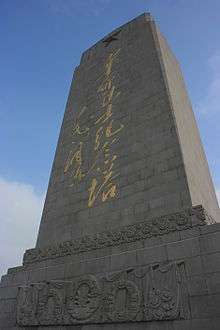
After World War II
Japanese troops controlled Jinan until their defeat in 1945. After this, the Kuomintang regained short-lived control of the city during the period from 1946 to 1948. The provincial government during this time was led by Lieutenant-General Wang Yaowu, who also commanded the KMT army in the region. KMT rule over Jinan ended in September 1948 with the Battle of Jinan in which units of the People's Liberation Army under the command of Chen Yi took the city. The battle for Jinan took a decisive turn in favor of the attackers when KMT Lieutenant-General Wu Huawen defected to the Communist side with about 8,000 of his troops.[35] The most likely explanation for his defection is that he had been pressured through relatives of his who were held captive by the Communist forces.[35] Lieutenant-General Wu had been in charge of the vital outer ring of defenses that protected the main airfield, the railroad station, and the commercial district.[35] With these critical assets lost, the situation of the city's defenders became untenable. Following the weakening of the city's defenses, the People's Liberation Army breached the city wall and entered Jinan on September 24, 1948.
Cultural Revolution
In March 1966, the largest among the drawn-out sequence of earthquakes that made up the Xingtai earthquake damaged about 36,000 houses in Jinan.[36]
On May 27, 1966, the Cultural Revolution started in Jinan with an article in the local newspaper "Jinan Evening News" (济南晚报) that denounced vice-governor Yu Xiu as a Bourgeois agent within the government.[36] Starting from early June 1966, the schools in Jinan were closed down by strikes as teachers were "struggled against". At the same time, big-character posters started to appear in the city.[36] Red Guards took to the streets of Jinan from late August 1966 onwards, damaging cultural heritage and setting up courts to prosecute perceived enemies of the revolution. In the spring of 1967, the "May 7th Incident" took place: When Zhang Chunqiao and Yao Wenyuan, both later reviled as members of the Gang of Four, visited Jinan to support the Cultural Revolution and its local leader Wang Xiao Yu, fighting erupted in the front of the provincial government between two rival factions of the Cultural Revolution, the "April 22nd Group" and Wang Xiao Yu's "April 28th Group". In the end, more than 10,000 people had been involved in the fighting.[37] On October 11, 1967, the tallest statue of Mao Zedong in Shandong province was erected on the campus of Shandong Normal University.[38] On September 17, 1968, a large assembly of Jinan workers celebrated the arrival of a mango fruit in the "August 1st" Meeting Hall. The fruit had been a gift to the workers in Beijing by Mao and was subsequently passed on to the workers in Jinan. In November 1968, Wang Xiao Yu began to agitate against the local army units in Jinan and Shandong Province. By then unrest due to the Cultural Revolution had severely damaged the city's governmental and industrial infrastructure, with about 80 percent of all government institutions shut down.[39] Large public protests were staged on April 4 and 5, 1969, in which approximately 500,000 people protested the occupation of Zhenbao Island by the Soviet Union.[40] On July 29, 1970, the leadership of the Cultural Revolution passed a resolution to make sweeping changes to the city's educational system: The liberal arts departments of Shandong University were moved to Qufu and combined with Qufu Normal College to form a new Shandong University. The biology department was moved to Tai'an and merged into the Shandong Agricultural College. The rest of the sciences were to form the Shandong Science and Technology University. Shandong Normal University was to be moved to Liaocheng. Shandong Medical College and Shandong College of Traditional Chinese Medicine were to be merged and moved to Tai'an.[41] Shandong University was restored in its original form and the "Shandong Science and Technology University" was abolished in early 1974.[42] The first reversals of Cultural Revolution policies started in early 1971: On May 23 of that year, the Shandong Provincial Museum was reopened after having been closed for about 5 years (since May 1966).[43] In the next year, the Jinan Committee for the Cultural Revolution officially reverted the name changes of four city districts enacted in 1966. During the 6 years between the name change and its reversal, Lixia District had been known officially as "Hongwei", Tianqiao as "Face the Sun", Huaiyin as "East Wind", and Shizhong as "Red Flag".[44] As the Cultural Revolution came to an end, Jinan started to receive visitors from abroad. For example, it was visited by a delegation from the United States Congress between August 8 and 11, 1975.[45] On September 18, 1976, Mao's death was mourned by about 600,000 people at an official service in Jinan's August 1 Square.[46]
Post 1990s
Jinan was the host of the 11th All China Games during October 2009. These games are the selection games for the Chinese Olympic champions. For this occasion, security was heightened and a full volunteer force was out on the streets directing visitor traffic. The city conducted major renovations in its transportation and recreation services in anticipation of the Games' visitors.[47]
2019
At the beginning of January, the State Council of the People's Republic of China approved the approval of Shandong Province to adjust the administrative division of Laiwu City and Jinan City, cancel Laiwu City, and all jurisdiction of former Laiwu City belongs to Jinan City; establish Laiwu District of Jinan City to replace the former Laicheng District of Laiwu City with the same administrative area; establish Gangcheng District of Jinan City to replace the former Gangcheng District of Laiwu City with the same administrative area.[48]
Geography and climate
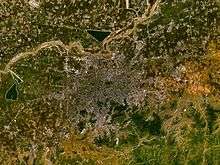
Geography
Jinan is located in the north-western part of Shandong province at 36° 40′ northern latitude and 116° 57′ east of Greenwich, about 400 kilometres (250 mi) south of the national capital of Beijing. It borders Liaocheng to the southwest, Dezhou to the northwest, Binzhou to the northeast, Zibo to the east, and Tai'an to the south. In the relief of the region, the city occupies a transition zone between the northern foothills of the Taishan Massif to the south of the city and the valley of the Yellow River to the north. Karst aquifers in limestone formations sloping down from the south to the north give rise to many artesian springs in the city center as well as in surrounding areas.
Climate
Jinan has a humid subtropical (Köppen: Cwa), considering a normal isotherm of −3 °C, or a humid continental climate (Köppen: Dwa), considering an isotherm of 0 °C but favoring the former, with four well-defined seasons. The city is dry and nearly rainless in spring, hot and rainy in summer, crisp in autumn and dry and cold (with little snow) in winter. The average annual temperature is 14.70 °C (58.5 °F), and the annual precipitation is around slightly above 670 millimetres (26.4 in), with a strong summer maximum, and high variability from year to year. January is the coldest and driest month, with a mean temperature of −0.4 °C (31.3 °F) and 5.7 millimetres (0.22 in) of equivalent rainfall. July is the hottest and wettest month, the corresponding numbers are 27.5 °C (81.5 °F), and 201.3 mm (7.93 in). With monthly percent possible sunshine ranging from 48 percent in July to 63 percent in May, the city receives 2,547 hours of bright sunshine annually.
Due to the mountains to the south of the city, temperature inversions are common, occurring on about 200 days per year.[49] The high precipitation for northern Chinese standards, in tandem with the topography (mountains surrounding the city on three sides), leads to particularly oppressive summer weather and the city being named as a candidate for the fourth "furnace", c.e. Three Furnaces.[50] Extremes since 1951 have ranged from −19.7 °C (−3 °F) on 17 January 1953 to 42.5 °C (109 °F) on 24 July 1955.[51][52]
| Climate data for Jinan (1971–2000) | |||||||||||||
|---|---|---|---|---|---|---|---|---|---|---|---|---|---|
| Month | Jan | Feb | Mar | Apr | May | Jun | Jul | Aug | Sep | Oct | Nov | Dec | Year |
| Record high °C (°F) | 20.2 (68.4) |
25.7 (78.3) |
30.2 (86.4) |
36.3 (97.3) |
39.7 (103.5) |
41.2 (106.2) |
42.5 (108.5) |
40.7 (105.3) |
38.5 (101.3) |
33.7 (92.7) |
26.5 (79.7) |
19.2 (66.6) |
42.5 (108.5) |
| Average high °C (°F) | 3.9 (39.0) |
6.9 (44.4) |
13.3 (55.9) |
21.6 (70.9) |
27.1 (80.8) |
31.6 (88.9) |
31.9 (89.4) |
30.6 (87.1) |
26.9 (80.4) |
21.2 (70.2) |
13.0 (55.4) |
6.0 (42.8) |
19.5 (67.1) |
| Daily mean °C (°F) | −0.4 (31.3) |
2.2 (36.0) |
8.2 (46.8) |
16.1 (61.0) |
21.8 (71.2) |
26.3 (79.3) |
27.5 (81.5) |
26.3 (79.3) |
22.0 (71.6) |
16.1 (61.0) |
8.3 (46.9) |
1.8 (35.2) |
14.7 (58.5) |
| Average low °C (°F) | −3.9 (25.0) |
−1.6 (29.1) |
3.9 (39.0) |
11.3 (52.3) |
16.8 (62.2) |
21.6 (70.9) |
23.6 (74.5) |
22.5 (72.5) |
17.7 (63.9) |
11.8 (53.2) |
4.5 (40.1) |
−1.7 (28.9) |
10.5 (51.0) |
| Record low °C (°F) | −19.7 (−3.5) |
−16.5 (2.3) |
−11.3 (11.7) |
−1.9 (28.6) |
4.2 (39.6) |
10.9 (51.6) |
14.0 (57.2) |
12.8 (55.0) |
6.4 (43.5) |
0.0 (32.0) |
−10.1 (13.8) |
−16 (3) |
−19.7 (−3.5) |
| Average precipitation mm (inches) | 5.7 (0.22) |
8.5 (0.33) |
15.3 (0.60) |
27.4 (1.08) |
46.6 (1.83) |
78.3 (3.08) |
201.3 (7.93) |
170.3 (6.70) |
58.5 (2.30) |
36.5 (1.44) |
16.2 (0.64) |
8.2 (0.32) |
672.8 (26.47) |
| Average precipitation days (≥ 0.1 mm) | 2.9 | 3.1 | 3.9 | 5.1 | 6.5 | 8.2 | 13.3 | 11.6 | 6.5 | 4.6 | 3.9 | 3.2 | 72.8 |
| Average relative humidity (%) | 53 | 51 | 47 | 46 | 51 | 55 | 72 | 75 | 64 | 58 | 56 | 55 | 57 |
| Mean monthly sunshine hours | 170.9 | 172.4 | 212.8 | 242.9 | 275.2 | 258.2 | 214.5 | 219.0 | 221.1 | 215.1 | 177.1 | 167.6 | 2,546.8 |
| Percent possible sunshine | 56 | 57 | 58 | 62 | 63 | 59 | 48 | 52 | 59 | 62 | 58 | 56 | 58 |
| Source: China Meteorological Administration[53] | |||||||||||||
Air quality
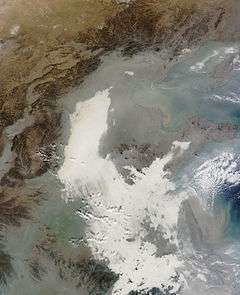
According to the National Environmental Analysis released by Tsinghua University and The Asian Development Bank in January 2013, Jinan is one of ten most air polluted cities in the world. Also according to this report, 7 of 10 most air polluted cities are in China, including Taiyuan, Beijing, Urumqi, Lanzhou, Chongqing, Jinan and Shijiazhuang.[54] As air pollution in China is at an all-time high, several northern cities are among the most polluted cities and has one of the worst air quality in China. Reporting on China's air quality has been accompanied by what seems like a monochromatic slideshow of the country's several cities smothered in thick smog. According to a survey made by "Global voices China" in February 2013, Jinan is among China's 10 most polluted cities, and is the only Shandong city to be on this list. Other cities on the blacklist includes major Chinese cities like Beijing, Shijiazhuang, Zhengzhou, and 6 other prefectural cities all in Hebei Province.[55] These cities are all situated in traditional geographic subdivision of "Huabei (North China) Region".
A dense wave of smog began in the Central and Eastern part of China on 2 December 2013 across a distance of around 1,200 kilometres (750 mi),[56] including Jinan and surrounding Shandong area. A lack of cold air flow, combined with slow-moving air masses carrying industrial emissions, collected airborne pollutants to form a thick layer of smog over the region.[57] Officials blamed the dense pollution on lack of wind, automobile exhaust emissions under low air pressure, and coal-powered district heating system in North China region.[58] Prevailing winds blew low-hanging air masses of factory emissions (mostly SO2) towards China's east coast.[59]
Administrative divisions
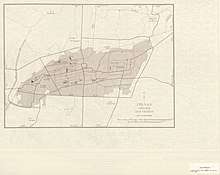
The sub-provincial city of Jinan has direct jurisdiction over ten districts and 2 counties after the annexation of Laiwu to Jinan in 2019:
| Map | ||||||
|---|---|---|---|---|---|---|
| Subdivision | Simplified Chinese | Hanyu Pinyin | Xiao'erjing | Population (2010) | Area (km²) | Dens. (/km²) |
| Inner city | ||||||
| Lixia District | 历下区 | Lìxià Qū | لِﺷﯿَا ﺛُﻮْ | 754,136 | 101.18 | 7476.13 |
| Shizhong District | 市中区 | Shìzhōng Qū | شِذْﻮ ﺛُﻮْ | 713,581 | 281.49 | 2545.51 |
| Huaiyin District | 槐荫区 | Huáiyìn Qū | ﺧُﻮَىْىٍ ﺛُﻮْ | 476,811 | 151.61 | 3144.13 |
| Tianqiao District | 天桥区 | Tiānqiáo Qū | 688,415 | 258.97 | 2660.94 | |
| Inner suburbs | ||||||
| Licheng District | 历城区 | Lìchéng Qū | 1,124,306 | 1301.21 | 862.27 | |
| Changqing District | 长清区 | Chángqīng Qū | 578,740 | 1208.59 | 478.88 | |
| Jiyang District | 济阳区 | Jǐyáng Qū | 517,948 | 1098.81 | 472.09 | |
| Outer suburbs | ||||||
| Zhangqiu District | 章丘区 | Zhāngqiū Qū | 1,064,210 | 1719.09 | 618.26 | |
| Laiwu District | 莱芜区 | Láiwú Qū | 989,535 | 1739.61 | 518.93 | |
| Gangcheng District | 钢城区 | Gāngchéng Qū | 308,994 | 506.42 | 910.04 | |
| Rural counties | ||||||
| Pingyin County | 平阴县 | Píngyīn Xiàn | 331,712 | 715.06 | 463.81 | |
| Shanghe County | 商河县 | Shānghé Xiàn | 564,125 | 1162.40 | 484.98 | |
These are further divided into 146 township-level divisions, including 65towns, 27 townships and 54 subdistricts.
Economy
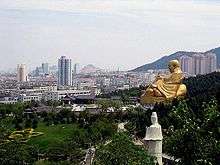
With the shift of the Yellow River to a new bed right to the north of Jinan (in 1852) and the establishment of a railroad hub, the city became a major market for agricultural products from the productive farming regions to the north.[9] Following the trade in agricultural goods, the city developed a textile and clothing industry, flour mills, oil presses, as well as factories producing paper, cement, and matches.[9] In the 1950s, large iron and steel works as well as chemical factories were established around Jinan. The large metal works produce pig iron, ingot steel, as well as finished steel.[9] In 2008, steel manufacturing was restructured with the formation of the Shandong Iron and Steel Group. In the 1970s, Sinotruk established its headquarters and factories for the production of trucks and construction vehicles in the city.[60]
Jinan has a pool of high-quality labor resources. There are 18 universities and colleges in the city where more than 200,000 students are studying. Among the over 200 research institutes in the city, 10 are national laboratories.
The focus on technology-intensive industries has transformed Jinan from a city supported by heavy industry and textiles to a city with more diverse industrial structure. Information Technology, transportation tools, home appliances, and bio-engineered products, among others, have become important components of the area's industry. Jinan's IT-related economic output was ranked to be in the fourth place nationally in 2004 .
Industrial zones include:
- Jinan High-tech Industrial Development Zone
Founded in 1991, the Jinan High-tech Industrial Development zone was one of the first of its kind approved by the State Council. The zone is located to the east of the city and covers a total planning area of 83 km2 (32 sq mi) that is divided into a central area covering 33 km2 (13 sq mi), an export processing district of 10 km2 (3.9 sq mi), and an eastern extension area of 40 km2 (15 sq mi). Since its foundation, the Jinan High-tech Industrial Development Zone has attracted enterprises as LG, Panasonic, Volvo, and Sanyo. In 2000, it joined the world science and technology association and set up a China-Ukraine High-tech Cooperation Park. The Qilu Software Park became the sister park of Bangalore park of India.[61]
- Jinan Export Processing Zone
The export processing zone is located in the eastern suburbs of Jinan, to the east of the Jinan High-tech Industrial Development Zone and to the north of the Jiwang highway. The distances to the Jiqing Highway and the Jinan Airport are 9 km (5.6 mi) and 18 km (11 mi) respectively.[62]
- Liaocheng Economic Development Zone
Demographics
In 2005, the estimated population of the entire area under the jurisdiction of Jinan City was 5.69 million, with a total of 2.54 million living in urban areas. By 2009, the total population had grown to about six million. The census in 2010 counted 6.814 million inhabitants out of which about 4.335 million were living in 6 urban districts which made up the built-up area.[4]
The encompassing metropolitan area was estimated by the OECD (Organisation for Economic Co-operation and Development) to have, as of 2010, a population of 11 million.[1]
The population is predominantly Han (98.3 percent), with very small portions of Hui and Manchu Chinese. Jinan has a significant Muslim community centred in the city's Muslim quarter, located to the west of the historical center.
Culture and contemporary life
Dialect
Local residents in the city proper, as well as in the surrounding areas, have traditionally spoken the Jinan dialect of Mandarin that is not readily understood even by native speakers of standard Mandarin. The younger people of Jinan are more likely to speak standard Mandarin, whereas many older residents retain strong local dialect elements in their speech. Nevertheless, even the younger residents of Jinan tend to retain a strong local accent and mix local vocabulary into the standardized Mandarin vocabulary. Due to the influx of migrant workers during the past decade of China's economic boom, many of the current population that are of working age are not natives of Jinan but have learned to understand the Jinan dialect.
Cuisine
Jinan has its own cuisine, the Jinan style of the Shandong cuisine, one of the Eight Culinary Traditions of China. One of its features is the use of soup in its dishes. Modern cuisines in northern China —Beijing, Tianjin and the northeastern regions including Heilongjiang, Jilin and Liaoning— are all branches of Shandong cuisine.
Shopping centers
Most shopping malls in Jinan are in the downtown area centered around Spring City Square and Quancheng Road (泉城路; 'spring city road'). Spring City Square was built by the municipal government beside the city moat in the early 21st century; at the center is the statue "Spring" which has become a symbol of Jinan. The square borders on the ancient city moat. It has a music fountain, a 46,000 square meter underground shopping center and a memorial hall with statues of famous people from Shandong.
Spring City Road was rebuilt at the same time that Spring City Square was created. The government's intention was to create a modern business district and yet preserve the traditional Chinese culture. Therefore, newly built shopping malls with traditional Chinese architectural styles and modern western skyscrapers can be found side by side along Spring City Road. Notable retail businesses are Quancheng Bookstore – the largest bookstore of the city – and Walmart (near the western end of Spring City Road). Major shopping malls along the road are the Guihe Shopping Center (贵和商厦), the Sofitel Silver Plaza, the Shimao international shopping center, and the Wanda Shopping Mall (万达集团). Parc 66 (济南恒隆广场) to the south of Spring City Road (opposite of Water Lily Street), opened in August 2011, is Jinan's largest shopping mall with seven levels of retail space and a total gross floor area of 171,000 square meters.[63]
Infrastructure
Healthcare system
- Shandong Provincial Hospital (SPH, 山东省立医院), address: 324 Jingwu Weiqi Road (36°39′24.6″N 116°58′39.7″E)
- Second Hospital Attached to Shandong University (山东大学第二医院)
- Stomatological Hospital Attached to Shandong University (山东大学附属口腔医院)
- Central Hospital of Jinan City (济南市中心医院), address: 105 Jiefang Road (36.667°N 117.0417°E)
- Qilu Hospital (山东大学齐鲁医院), address: 107 Wenhuaxi Road (36°39′25.6″N 117°0′41.25″E)
- Jinan No. 1 People's Hospital (济南市第一人民医院), address: 132 Daminghu Road
- Jinan No. 2 People's Hospital (济南市第二人民医院), also known as "Eye Hospital of Jinan" (济南眼科医院)
- Jinan No. 3 People's Hospital (济南市第三人民医院)
- Jinan No. 4 People's Hospital (济南市第四人民医院), address: 50 Shīfàn Road
- Jinan No. 5 People's Hospital (济南市第五人民医院), address: 447 Jīngshí Road
- No. 456 Hospital of the People's Liberation Army (中国人民解放军第四五六医院, formerly Jinan Airforce Hospital, 空军济南医院)
- Pediatric Hospital of Jinan City (济南市儿童医院)
- Jinan Infectious Disease Hospital (济南市传染病医院), address: 173 Jīngshí Road (36°38′56″N 116°59′17″E)
- Qianfoshan Hospital (千佛山医院), address: 66 Jingshi Road (36°38′52.04″N 117°2′13.33″E)
- Jinan military hospital (济南军区总医院)
Transportation
Railways
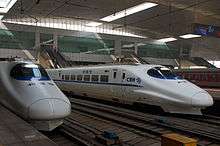
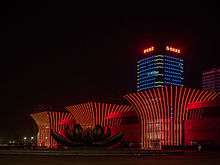
Jinan is positioned at the intersection of two major railways: The Jinghu Railway that runs from Beijing to Shanghai is the major north–south backbone of the railway system in eastern China. In Jinan, it intersects with the Jiaoji Railway that connects Jinan to the sea port of Qingdao to the east. In addition, the Hanji Railway connects Jinan to the city of Handan (Hebei Province) in the west. Within Shandong province, the Jinghu Railway connects Jinan with the cities of Dezhou, Tai'an, Jining, and Zaozhuang; the Jiaoji Railway provides a link to the cities of Zibo, Qingdao, and Weifang; the Hanji Railway serves the cities of Yancheng and Liaocheng. Central Jinan is served by the Jinan Railway Station and the Jinan East Railway Station (just by Daming Lake).
The Beijing–Shanghai High-Speed Railway calls at the new Jinan West Railway Station, which is outside the central metropolitan center and is in suburban western Jinan's Huaiyin District. Since it opened for public service on 30 June 2011,[64] it has become a future hub with west–east running high speed railways to Taiyuan, Shijiazhuang and Qingdao.
Expressways
Major expressways include China National Highway 104, China National Highway 220, and China National Highway 309. Because of Jinan's location and role as a road and rail transportation hub, the Jinan Coach Terminus has one of the largest passenger flows nationally. On peak travel days, as many as 92,000 passengers per day have been counted, on off-peak days the number is around 42,000 passengers per day.[65]
Airport
Jinan Yaoqiang International Airport is located about 33 km (21 mi) northeast of the city center and to the north of the town of Yaoqiang from which the name of the airport is derived. The airport is connected to the city center of Jinan by expressways. It has domestic flights to many of the major cities in China as well as to international destinations, in particular Helsinki,[66] Osaka,[67] Seoul, Paris, Bangkok and Singapore.
Public transportation
Jinan's urban public transportation history began in 1938, and the city is now a major bus transportation hub. To ensure that buses have priority, most of the city's urban main roads have a bus lane, and bus rapid transit signal priority measures are gradually being implemented. The Jinan urban area has more than 220 public transportation routes.
According to the properties of bus lines, Jinan's urban bus network can be divided into five categories:
- Bus rapid transit system: The Jinan BRT has 7 routes, connected by transfer stations. As a result of the BRT's isolated central lanes, signal priority and other measures, bus speeds have been greatly improved, improving public transport. Price:¥2.
- Conventional buses: Have air-conditioned and non-air-conditioned buses. Air-conditioned lines have a K perfix on their route numbers. Form 2018, most lines are air-conditioned lines (Include lines without K perfix).[68] These lines comprise more than 200 routes covering the whole city. Price:¥1 (Air-conditioned is¥2).
- Public trolleybuses: the Jinan trolleybus system, opened in 1977, once had 10 lines, but now has only four. These are Jinan's most important bus routes. Price: ¥1.
- Suburban and exurban buses – Operated by air-conditioned and non-air-conditioned vehicles. Most of these buses carries passengers from suburban/exurban area to urban area, while the others provide village-to-village or village-to-county service. Price: Varies from ¥1 to ¥12.
- Student, supermarket and particular business bus lines – These are for large schools, supermarkets, business transfer students, customers, employees of private businesses. They operate side by side with the other bus systems.
Started by construction in 2013, Jinan Metro will open in 2018[69] and then will be extended to 3 lines toward 2030.
Main tourist attractions
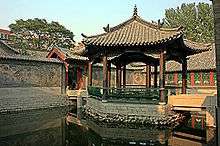
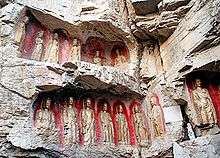
Jinan is renowned across China for its numerous springs, the lakes fed by the spring water, and the weeping willows that grow along the water edges. The late-Qing author Liu E describes Jinan's cityscape in his novel "The Travels of Lao Can" (老残游记, written 1903–04, published in 1907) as "Every family has spring water, every household has a willow tree".[70] Jinan was also the historical center of Buddhist culture for the whole province which is still manifest in the many historic sites that are left behind in its southern counties.
Springs and lakes
Jinan is known as the "City of Springs" because of the large number of natural artesian springs. The majority of the springs, many of which have been historically listed under the "72 Famous Springs" (七十二名泉) are concentrated in the downtown district and flow north to converge in Daming Lake.[7] The Baotu Spring Park is the most popular of the springs in the City of Jinan proper. Besides the Baotu Spring, the park contains several other springs that are listed among the "72 Famous Springs". "Bào tū" (趵突) means "jumping and leaping" in Chinese. The water in the spring pool can be seen foaming and gushing, looking like a pot of boiling water. The spring was visited by the Qianlong Emperor (1711–1799) of the Qing dynasty who declared it "the best spring under the heaven" (Chinese: 天下第一泉; pinyin: tiān xià dì yī quán). A tablet with the Emperor's handwriting "Baotu Spring" has since been erected beside the spring pool.
Not far away to the northeast of Baotu Spring Park is the Daming Lake, which, together with Baotu Spring and the Thousand-Buddha Mountain is often regarded as the "Three Greatest Attractions in Jinan". Other notable parks in the city include the Five Dragon Pool (五龙潭) near the Baotu Spring Park, the Black Tiger Spring (黑虎泉) on the southern city moat, and the Baimai Springs (百脉泉) of Zhangqiu City to the east of Jinan.
Buddhist sites
Historic Buddhist sites are particularly common in Licheng County to the south-east of the city center of Jinan. The Four Gates Pagoda, built in 661, is the oldest existing one-story stone tower in China. The pagoda houses four Buddhist statues dating from the 6th century, and the Cypress tree (九顶松) standing next to the pagoda is more than 1000 years old. Below the hill on which pagoda stands lie the remnants of the Shentong Temple (神通寺), which was founded in the 4th century but was destroyed in the wars of later dynasties. The funerary stelae of monks from the temple which date from different historic periods display remarkable artistic features. The statues in the nearby Thousand-Buddha Cliff form one of the best collections of Tang dynasty Buddhist statues in the region.
The Lingyan Temple in the southern county of Changqing was one of the four most famous temples (四大名刹) of the Tang dynasty. The temple was founded during the Jin dynasty and reached its heyday during the Tang and Song dynasties. During the Tang dynasty, the famous monk Xuanzang stayed in the temple and translated Buddhist manuscripts he had brought to China from India. Many emperors in Chinese history visited the temple before they went to Mount Tai (one of China's five sacred mountains, located south of Jinan) for ceremonies. The clay sculptures of Buddhas made in the Song dynasty are considered as "The Best of China" by scholar and journalist Liang Qichao. Buddhist architectures within the temple such as pagodas and tomb stelae are among the earliest and best protected in the region.
Museums and libraries
The Shandong Provincial Museum located at the foothill of Thousand-Buddha Mountain is the largest museum in the province. It has a large collection of natural as well as historical treasures from the whole province. The museum was established in its present form in 1982 and currently has 8 exhibition halls : "Treasures of Shandong Province"; "Stone Sculptures"; "Warship of the Ming dynasty"; "Ancient Coins"; "Art Treasures"; "Fossil Collections"; "Dinosaurs"; and "Specimens". The museum has more than 210,000 relics and specimens, making up ⅓ of the collections in museums of whole province. The Shandong Provincial Museum has been ranked No. 7 in terms of collection size among the museums of China.
The Shandong Art Museum holds a large collection of fine arts.
The Jinan Municipal Museum [71] is located at the south-western foot of the Thousand-Buddha Mountain, in the north of the city center. Although much smaller than the provincial museum, the municipal museum still houses a collection of more than 20,000 items, most of which were recovered in the city area.
The Shandong Provincial Library [72] in the eastern High-tech Park (address: 2912 Second Ring East Road) is the principal library of the province and is ranked among the Top 10 Chinese libraries. As of 2004, the library had more than 5.18 million documents, many of which date back many centuries and are important sources for research on Chinese history. The library also has a large collection of western journals/books. Originally, the library was built close to Daming Lake in 1909 by the then governor of Shandong. In the late 1990s, a project was undertaken to move the library to the eastern part of the city, and it reopened in 2002 with 35 reading rooms and more than 2000 seats.
Parks and Nature Reserves
Jinan Hundred Miles Yellow River Scenic Area is located in No.166 Luokou Huancheng Road in Tianqiao District.[73] It is designed as an ecological cultural theme park which focuses on ecological tourism, cultural tourism, and healthy tourism. The Yellow River of this section stretches 51.98 kilometers.[74] Jinan Hundred Miles Yellow River Scenic Area was awarded the title "Fifty Scenes of the Yellow River in China" on September 12, 2018.[75] The Levee extending along the Yellow River in this scenery area, is praised as "the Great Wall over water".[73]
Yellow River Forest Park (Jinan) is located on the north bank of the Yellow River. The Yellow River Forest Park sprawls over 1500mu (100 hectares) and has 300,000 trees of various breeds.[76] Yellow River Forest Park is the only park equipping with a forest racecourse, which has a course of 3 Li (unit), in Jinan City.[77] Yellow River Forest Park provides not only an area covering 5000 square meters for visitors to freely barbecue but also a fishing pond covering 1,800 square meters. Visitors can participate in various activities here, such as roller skating, cue sports, table tennis, archery, shooting, etc.
Daming Lake Park is located in the center of Jinan City, covering an area of 46.5 hectares. Daming Lake Park is considered as one of the "Three Must-see Tourist Spots of Jinan" (the others are Baotu Spring Park and Thousand-Buddha Mountain). Daming Lake Park has many scenic spots, such as the Daming lake and the Lixia Pavilion. Daming Lake is a natural lake consisting of many springs. It is unique because the lake has constant water level unaffected by heavy rains or drought.[78] Lixia Pavilion, which was built in the Northern Wei period, is in the center of the Daming Lake. There are so many ancient buildings in Daming Lake Park that it has an title describing them, which is "One terrace, three gardens, three towers, four ancestral halls, six isles, seven bridges and ten pavilions".[79]
Education
Universities and colleges
- Qilu Normal University (齐鲁师范学院, formerly Shandong Educational Institute: 山东教育学院)[80]
- Qilu University of Technology (山东轻工业学院, or Shandong Polytechnic University)[81]
- Shandong Architectural Institute (山东建筑大学)
- Shandong College of Electronic Technology (山东电子职业技术学院)[82]
- Shandong Jiaotong University (山东交通学院)[83]
- Shandong Normal University (山东师范大学)
- Shandong Polytechnic (济南铁道职业技术学院, formerly Jinan Railway Polytechnic)[84]
- Shandong Sport University (山东体育学院)[85]
- Shandong University
- Shandong University of Art and Design (山东工艺美术学院)[86]
- Shandong University of Arts (山东艺术学院)[87]
- Shandong University of Finance and Economics[88]
- Shandong University of Science and Technology, which also has campuses in Qingdao and Tai'an.
- Shandong University of Traditional Chinese Medicine[89]
- Shandong Women's University
- University of Jinan
Provincial high schools
- Shandong Experimental High School
- Jinan Foreign Language School
- The High School Affiliated to Shandong Normal University (山东师范大学附属中学)[90]
Military
Jinan is the former command center for the Jinan Military Region, one of the defunct seven military regions into which the People's Liberation Army is organized.[91] Jinan MR was considered as a strategic reserve of PLA. Jinan Military Region covered two of China's most populous provinces, Henan and Shandong.
Sports
The most renowned sports team in Jinan are the Shandong Golden Lions. The Shandong Golden Lions have been playing in the Chinese top basketball league for all the seasons (13 for basketball) since the league turned professional in 1995. The team's best season was 1997–1998 when it finished 3rd place. In the 2007–2008 season, the Shandong Golden Lions also reached the 3rd place at the end of the season, but they were knocked out at the first round of the playoffs.
The Shandong Luneng Football Club is the most widely known football team in Jinan. The club currently plays at the highest tier of Chinese football, the Chinese Super League. The Shandong Luneng Football Club is one of four clubs which have been playing in Chinese top football league every season since the league turned professional in 1994. Since 1994 the club has won 9 titles: Top League Champions (1999, 2006, 2008, 2010), FA Cups (1995, 1999, 2004, 2006), and CSL Cup (2004). Jinan was also one of four host cities of China during 2004 AFC Asian Cup.
In 2009, Jinan hosted the 2009 National Games of China, the premier sports event at the national level in China and the first major multi-sports event held in China after the 2008 Summer Olympics in Beijing. The National Games' main venue was the Jinan Olympic Sports Center.[92]
From 2014 Jinan is well known also as place of Chinese national winter swimming festivals at Daming Lake, since 2016 organized in cooperation with International Winter Swimming Association (IWSA). And in season 2019/2020 Jinan has become for the first time Chinese site of international winter swimming World cup [93] (as its 3rd stage [94] under the IWSA-rules).
Twin towns and sister cities
|
|
|
|
Notes
- In addition to the names in the infobox above, Jinan has also been romanized as Tse-nan.[2]
References
Citations
- OECD Urban Policy Reviews: China 2015, OECD READ edition. OECD iLibrary. OECD. 18 April 2015. p. 37. doi:10.1787/9789264230040-en. ISBN 9789264230033. ISSN 2306-9341. Archived from the original on 27 March 2017. Retrieved 9 December 2017.Linked from the OECD here Archived 2017-12-09 at the Wayback Machine
- "China" in the Encyclopædia Britannica, 9th ed., 1878.
- "Illuminating China's Provinces, Municipalities and Autonomous Regions-Shandong". PRC Central Government Official Website. 2001. Archived from the original on 2014-06-19. Retrieved 2014-04-22.
- "Communiqué of the National Bureau of Statistics of People's Republic of China on Major Figures of the 2010 Population Census". National Bureau of Statistics of China. Archived from the original on 2014-02-02.
- "Jinan (Shandong) City Information". HKTDC. Archived from the original on 2014-04-29. Retrieved 2014-04-28.
- 中央机构编制委员会印发《关于副省级市若干问题的意见》的通知. 中编发[1995]5号. 豆丁网. 1995-02-19. Archived from the original on 2014-05-29. Retrieved 2014-05-28.
- "Archived copy" 济南新72名泉评定前后. 163.com news. Archived from the original on 3 June 2016. Retrieved 9 May 2016.CS1 maint: archived copy as title (link)
- "The Geography of China". Archived from the original on 23 March 2017. Retrieved 9 May 2016.
- "Jinan". Britannica.com. Archived from the original on March 7, 2016. Retrieved February 11, 2016.
- The Travels of Marco Polo – The Complete Yule-Cordier Edition, Volume II
- Neolithic Painted Pottery, National Museum of History, Taipeh
- Needham, Joseph. 1978. The Shorter Science and Civilisation in China. Colin A. Ronan, ed. Cambridge: Cambridge University Press. pp.142-143 ISBN 0-521-21821-7
- 《第五批重点文物保护单位:汉济北王墓(古墓葬)》. 中国文明网 (in Chinese). Archived from the original on 2016-10-02. Retrieved 2009-10-03.
- Liu Guolin (刘国林). "Archived copy" 《济北王墓:一个诸侯王的身后事》. 大众网 (in Chinese). Archived from the original on 2009-09-03. Retrieved 2009-10-03.CS1 maint: archived copy as title (link)
- de Crespigny, p.39
- Morris Rossabi (1988): "Khubilai Khan: His Life and Times" Berkeley: University of California Press
- Li, Si (李斯). 1904年06月01日 胶济铁路通车. www.todayonhistory.com. Archived from the original on 3 September 2014. Retrieved 1 September 2014.
- "The Origins of the Boxer War". Archived from the original on 23 March 2017. Retrieved 9 May 2016.
- "The Soap Opera Paradigm". Archived from the original on 23 March 2017. Retrieved 9 May 2016.
- Waldron, Arthur (2003). From War to Nationalism: China's Turning Point, 1924-1925. Cambridge UP. p. 105. ISBN 978-0-521-52332-5. Archived from the original on 2017-03-23. Retrieved 2016-02-24.
- "Chinese Civilization". Archived from the original on 23 March 2017. Retrieved 9 May 2016.
- Iriye, After Imperialism, 195-200.
- Iriye, After Imperialism, 199-201.
- Ji'nan Government (September 1, 2005). "The Year of 1928". Archived from the original on July 24, 2012. Retrieved August 16, 2013.
蔡公时用日语抗议,日兵竟将其耳鼻割去,继又挖去舌头、眼睛。日军将被缚人员的衣服剥光,恣意鞭打,然后拉至院内用机枪扫射
- C. Martin Wilbur, "The Nationalist Revolution: from Canton to Nanking, 1923-1928," Cambridge History of China, Volume 12 Republican China, 1912-1949 Pt I (Cambridge: Cambridge University Press, 1983), 702–706.
- "Orbat.com" (PDF). Archived from the original (PDF) on 11 March 2016. Retrieved 9 May 2016.
- Jay Taylor, The Generalissimo: Chiang Kai-Shek and the Struggle for Modern China (Cambridge, MA: Belknap Press of Harvard University Press, 2009), 82–83.
- Frank Dorn, The Sino-Japanese War, 1937-41: From Marco Polo Bridge to Pearl Harbor (New York: Macmillan, 1974), pg. 81-82
- Dorn, pg. 81-82
- Diana Lary: "Treachery, Disgrace and Death: Han Fuju and China's Resistance to Japan" War in History 2006 13 (1) 65–90
- Kent G. Budge. "The Pacific War Online Encyclopedia: Tsinan". Archived from the original on 30 March 2016. Retrieved 9 May 2016.
- Dorn, pg. 82
- MacKinnon, Stephen R.; Capa, Robert (2008). Wuhan, 1938: War, Refugees, and the Making of Modern China. University of California Press. p. 18. ISBN 0-520-25445-7.
- Stephen MacKinnon, "The Tragedy of Wuhan, 1938", Modern Asian Studies, Vol. 30, No. 4, Special Issue: War in Modern China (October, 1996), pp. 931-943
- "OHINA: Province for a Poet". TIME.com. 4 October 1948. Archived from the original on 23 August 2013. Retrieved 9 May 2016.
- "Jinan City Government online records for 1966 (1st half)". Archived from the original on 2009-01-09. Retrieved 2009-01-01.
- "Jinan City Government online records for 1967 (1st half)". Archived from the original on 2009-01-09. Retrieved 2009-01-01.
- "Jinan City Government online records for 1967 (2nd half)". Archived from the original on 2009-01-09. Retrieved 2009-01-01.
- "Jinan City Government online records for 1968". Archived from the original on 2009-01-09. Retrieved 2009-01-01.
- "Jinan City Government online records for 1969". Archived from the original on 2009-01-09. Retrieved 2009-01-01.
- "Jinan City Government online records for 1970". Archived from the original on 2009-01-09. Retrieved 2009-01-01.
- City Government online records for 1974
- "Jinan City Government online records for 1971". Archived from the original on 2009-01-09. Retrieved 2009-01-01.
- "Jinan City Government online records for 1972". Archived from the original on 2009-01-09. Retrieved 2009-01-01.
- "Jinan City Government online records for 1975". Archived from the original on 2009-01-09. Retrieved 2009-01-01.
- "Jinan City Government online records for 1976". Archived from the original on 2009-01-09. Retrieved 2009-01-01.
- http://www.11th-games.org.cn/ Archived 2008-12-16 at the Wayback Machine 11th All China Games website
- 国务院批复同意山东省调整济南市莱芜市行政区划-新华网. Xinhua. 2019-01-09. Archived from the original on 2019-02-12. Retrieved 2019-02-11.
- ""Cleaner Production in China"". Archived from the original on 2008-11-21. Retrieved 2008-11-02.
- 高温逼出新"火炉"之争 济南城热门候选_山东新闻_新闻_腾讯网 (in Chinese). QQ News. 31 July 2007. Archived from the original on 26 May 2013. Retrieved 27 April 2013.
- "Archived copy". Archived from the original on 2013-03-18. Retrieved 2010-05-24.CS1 maint: archived copy as title (link)
- 中国气象科学数据共享服务网. China Meteorological Administration. Archived from the original on 2015-03-02. Retrieved 2014-02-22.
- 中国气象局 国家气象信息中心 (in Chinese). China Meteorological Administration. Archived from the original on 2013-03-18. Retrieved 2009-03-17.
- "Weather & Extreme Events: 7 of 10 Most Air-Polluted Cities Are in China". January 16, 2013. Imaginechina/Corbis. http://news.discovery.com. Archived from the original on 8 September 2014. Retrieved 1 September 2014.
- Bildner, Eli (February 27, 2013). "Interactive Maps of China's Most–and Least–Polluted Places". Global Voices China. http://newsmotion.org. Archived from the original on 3 September 2014. Retrieved 1 September 2014.
- "Smog Shrouds Eastern China". Earth Observatory. 10 December 2013. Archived from the original on 24 March 2014. Retrieved 24 March 2014.
- "Smog and fog hit east, north China". Xinhua News Agency. 6 December 2013. Archived from the original on 6 December 2013. Retrieved 15 May 2014.
- 三问今冬十面"霾"伏. 人民日报海外版 [People's Daily overseas version]. 2013-12-07. Archived from the original on 2013-12-22. Retrieved 2014-09-01 – via Xinhua.
- "Map: Shanghai's off the charts air pollution". Greenpeace. 6 December 2013. Archived from the original on 7 March 2014. Retrieved 24 March 2014.
- "Introduction CNHTC Archived 2008-05-08 at the Wayback Machine." China National Heavy Duty Truck Group. Retrieved on July 8, 2010. "The headquarters of China National Heavy Duty Truck Group Co., Ltd. (CNHTC) is located in Jinan, Shandong, P. R. China."
- "Ji'nan High-tech Industrial Development Zone". Archived from the original on 2 May 2014. Retrieved 9 May 2016.
- "Ji'nan Export Processing Zone". Archived from the original on 10 March 2016. Retrieved 9 May 2016.
- "Hang Lung - Home". Archived from the original on 22 January 2016. Retrieved 9 May 2016.
- "Jinan welcomes high-speed rail". Archived from the original on 4 March 2016. Retrieved 9 May 2016.
- "Jinan Coach Terminus official website (in Chinese)". Archived from the original on 2009-02-05. Retrieved 2008-12-28.
- "New long distance route to Asia: Tibet Airlines will commence flights from Jinan, China, to Helsinki Airport in the spring 2019". Archived from the original on 14 April 2019. Retrieved 9 April 2019.
- "Shandong Airlines to Resume Jinan – Osaka Service from late-October 2013". Archived from the original on 12 July 2015. Retrieved 9 May 2016.
- 年底济南公交车全部更新为空调车 还将推虚拟公交卡. Archived from the original on 2019-06-22.
- 田艳敏. 20131229济南新闻 济南轨道交通市域快线建设启动. Archived from the original on 4 March 2016. Retrieved 9 May 2016.
- Original simplified Chinese: 家家泉水,户户垂杨; traditional Chinese: 家家泉水,戶戶垂楊
- Jinan Municipal Museum Archived 2008-01-07 at the Wayback Machine
- "Shandong Provincial Library". Archived from the original on 2019-04-03. Retrieved 2019-04-27.
- "Jinan Baili Yellow River Scenic Area-Shandong-Places To Go-Exploring China - China – Beyond Your Imagination,China Overseas Tourism Promotion Website". www.travelchina.gov.cn. Archived from the original on 2018-11-27. Retrieved 2018-11-29.
- Jinan Baili Yellow River Scenic Area http://www.travelchina.gov.cn/sitefiles/gjly_en/html/meijing/4203.shtml Archived 2018-11-27 at the Wayback Machine Retrieved 2018-11-27
- “中国黄河50景”新鲜出炉_旅游. www.sohu.com. 2018-09-12. Archived from the original on 2018-11-28. Retrieved 2018-11-29.
- Li, Lina. "Jinan - ZhongWenHelp". www.zhongwenhelp.com. Archived from the original on 2017-05-06. Retrieved 2018-11-29.
- 黄河森林公园森林气息自然清新,度假游玩的绝佳境地!. baijiahao.baidu.com. Archived from the original on 2018-11-28. Retrieved 2018-11-29.
- "Daming Lake Park, Jinan". www.travelchinaguide.com. Archived from the original on 2018-11-27. Retrieved 2018-11-29.
- 济南三大名胜之大明湖. www.wutongzi.com. Archived from the original on 2018-11-29. Retrieved 2018-11-29.
- 齐鲁师范学院. Archived from the original on 23 April 2016. Retrieved 9 May 2016.
- "QILU UNIVERSITY OF TECHROLOGY". Archived from the original on 11 May 2016. Retrieved 9 May 2016.
- 欢迎访问山东电子职业技术学院. Archived from the original on 16 May 2016. Retrieved 9 May 2016.
- "Shandong Jiaotong University official website". Archived from the original on 2014-03-29. Retrieved 2014-03-31.
- 山东职业学院(原济南铁道职业技术学院). Archived from the original on 4 March 2016. Retrieved 9 May 2016.
- 山东体育学院. Archived from the original on 21 May 2016. Retrieved 9 May 2016.
- 外事办. Archived from the original on 31 May 2016. Retrieved 9 May 2016.
- 欢迎访问山东艺术学院. Archived from the original on 2016-06-23. Retrieved 9 May 2016.
- 山东财经大学欢迎您. Archived from the original on 23 May 2016. Retrieved 9 May 2016.
- Shandong University of Chinese Traditional Medicine official website Archived 2014-04-10 at the Wayback Machine
- "Senior High School Attached to Shandong Normal University official website". Archived from the original on 2014-03-31. Retrieved 2014-03-31.
- John Pike. "Jinan Military Region". Archived from the original on 11 March 2016. Retrieved 9 May 2016.
- 11th Chinese National Games opens in Jinan Archived 2014-04-29 at the Wayback Machine. Xinhua News Agency (2009-10-17). Retrieved on 2009-10-21.
- IWSA winter swimming World cup
- World cup 2019/2020 3rd stage
Bibliography
- de Crespigny, Rafe (2010). Imperial warlord : a biography of Cao Cao 155-220 AD. Leiden Boston: Brill. ISBN 978-90-04-18522-7.
- Akira Iriye, After Imperialism: The Search for a New Order in the Far East, 1921-1931 (Cambridge: Harvard University Press, 1965; reprinted:Chicago: Imprint Publications, 1990): 193-205
External links
| Wikimedia Commons has media related to Jinan. |
- Jinan Government website
- Compass foreign business service center

- . Encyclopædia Britannica (11th ed.). 1911.
- Yellow River
- 50 Scenes of the Yellow River in China
- Three Must-go Tourist Spots in Jinan
- Lixia Pavilion
- The Yellow River Forest Park


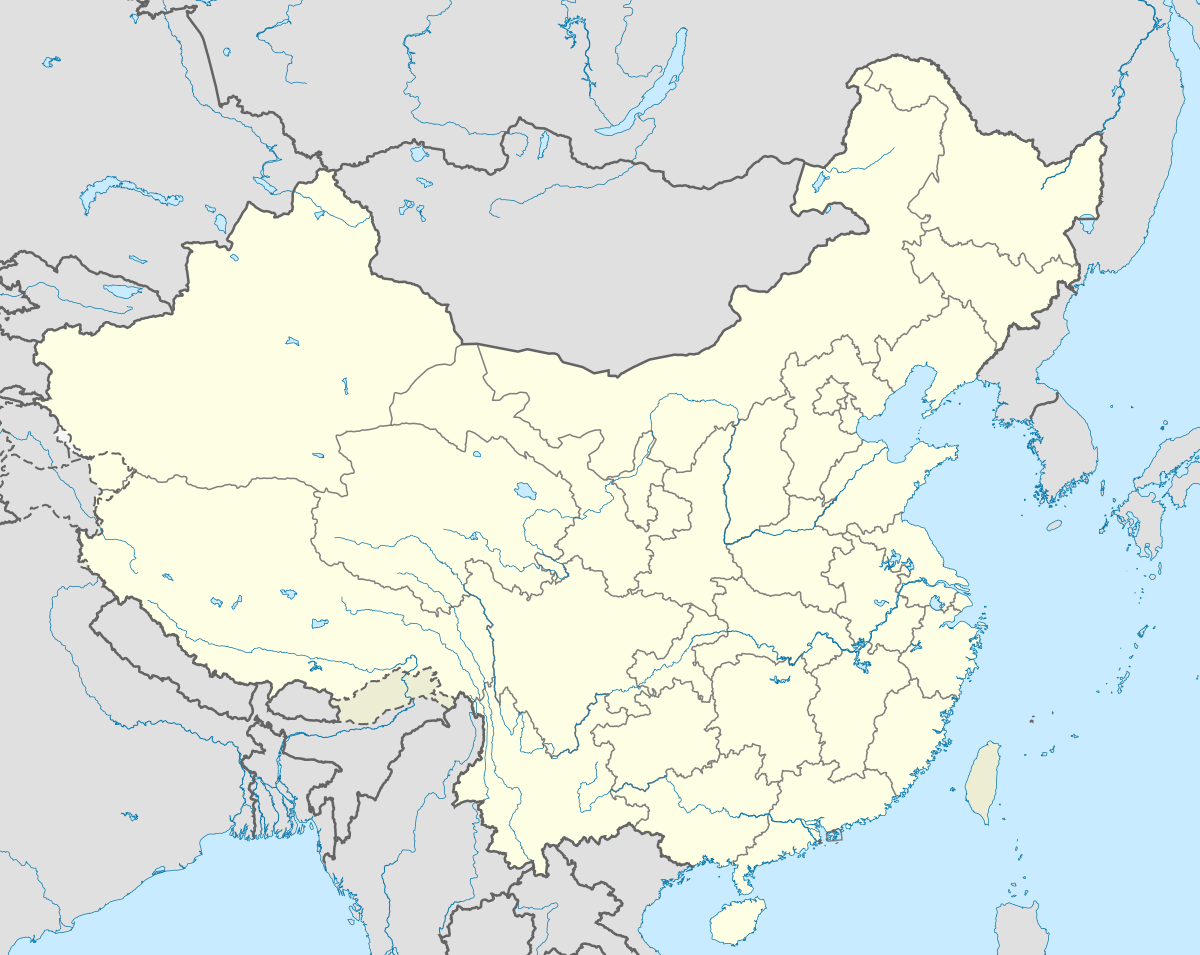
Handscroll%2C_ink_and_colors_on_paper%2C_28.4_x_93.2_cm_National_Palace_Museum%2C_Taipei.jpg)
